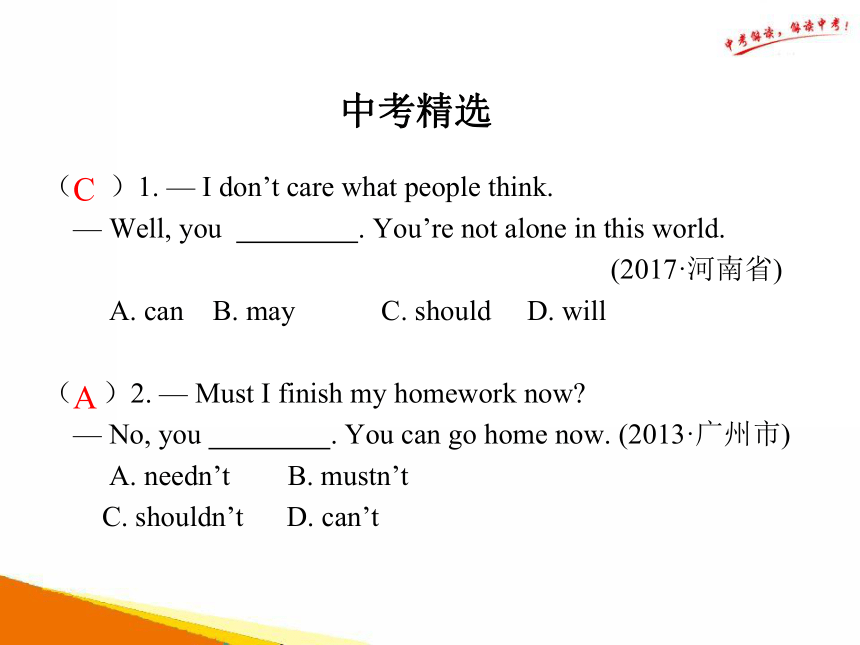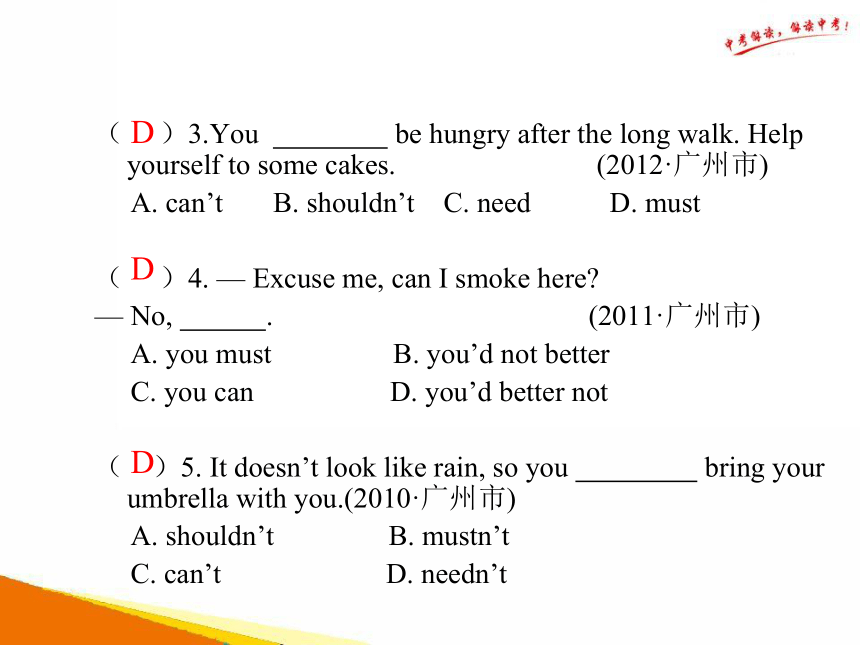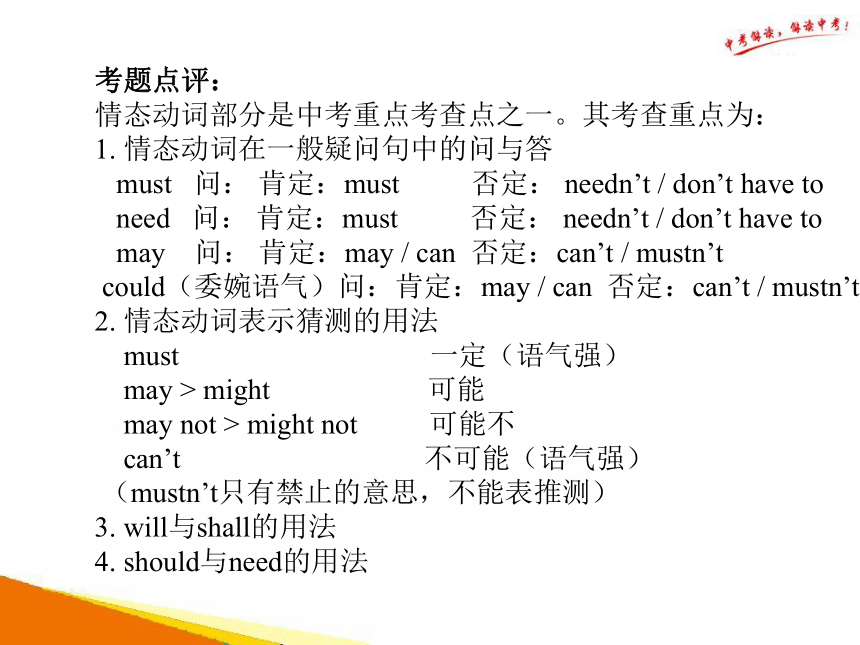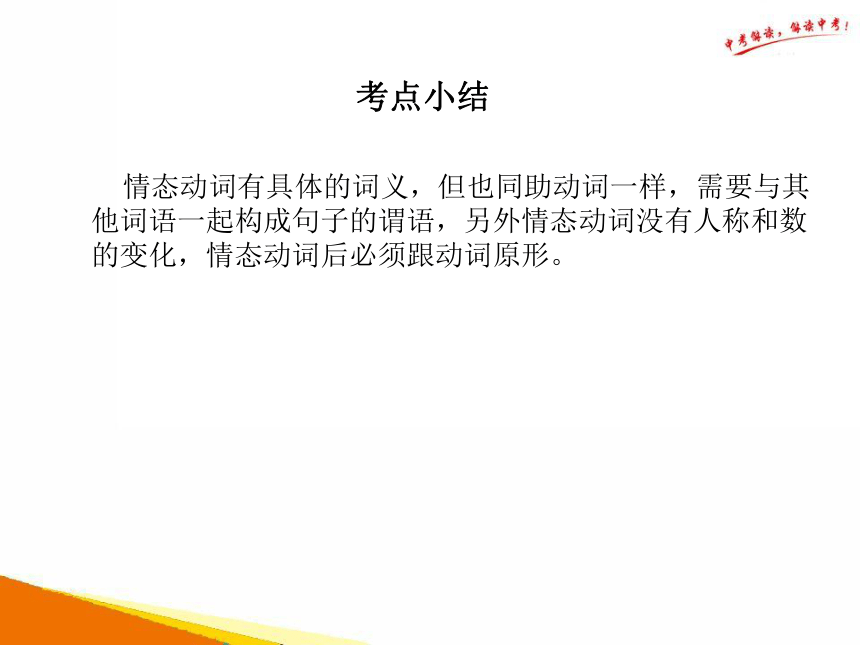2018年广州中考英语备考第八节情态动词课件
文档属性
| 名称 | 2018年广州中考英语备考第八节情态动词课件 |  | |
| 格式 | zip | ||
| 文件大小 | 903.5KB | ||
| 资源类型 | 教案 | ||
| 版本资源 | 牛津深圳版 | ||
| 科目 | 英语 | ||
| 更新时间 | 2018-05-15 16:27:26 | ||
图片预览






文档简介
课件12张PPT。第八节 情态动词( )1. — I don’t care what people think.
— Well, you . You’re not alone in this world.
(2017·河南省)
A. can B. may C. should D. will
( )2. — Must I finish my homework now?
— No, you . You can go home now. (2013·广州市)
A. needn’t B. mustn’t
C. shouldn’t D. can’tCA中考精选( )3.You be hungry after the long walk. Help yourself to some cakes. (2012·广州市)
A. can’t B. shouldn’t C. need D. must
( )4. — Excuse me, can I smoke here?
— No, . (2011·广州市)
A. you must B. you’d not better
C. you can D. you’d better not
( )5. It doesn’t look like rain, so you bring your umbrella with you.(2010·广州市)
A. shouldn’t B. mustn’t
C. can’t D. needn’tDDD考题点评:
情态动词部分是中考重点考查点之一。其考查重点为:
1. 情态动词在一般疑问句中的问与答
must 问: 肯定:must 否定: needn’t / don’t have to
need 问: 肯定:must 否定: needn’t / don’t have to
may 问: 肯定:may / can 否定:can’t / mustn’t
could(委婉语气)问:肯定:may / can 否定:can’t / mustn’t
2. 情态动词表示猜测的用法
must 一定(语气强)
may > might 可能
may not > might not 可能不
can’t 不可能(语气强)
(mustn’t只有禁止的意思,不能表推测)
3. will与shall的用法
4. should与need的用法考点小结 情态动词有具体的词义,但也同助动词一样,需要与其他词语一起构成句子的谓语,另外情态动词没有人称和数的变化,情态动词后必须跟动词原形。一、常见的情态动词的用法
1.can的用法
(1)表示能力时,与be able to同义,意为“能够,会”,但can只用于一般现在时而could多用于一般过去时,be able to可用于各种时态。
(2)表示允许、请求时,could比can 语气更加委婉客气,常用于“Could I / you …?”句型中,若表示同意时,用can回答而不用could。
如:— Could I use your pen?我可以用你的钢笔吗?
— Yes, you can.可以。
(3)can’t意为“不能,不会”,也可用于表示推测,意为“不可能”。
2.may 的用法
(1) 表示允许、请求时用法与can相似。在回答以may引起的问句时,肯定回答一般不用may这个词,而用其他方式,如“Yes, please.”或“Certainly.”,否定回答用can’t或mustn’t, 不能用may not。
(2) 表示推测,意为“可能,也许”,常用于肯定句中。
3.must的用法
(1) 表示义务,意为“必须”(主观意志);
否定形式 mustn’t, 意为“禁止,不允许”。
在回答以must引起的问句时,肯定回答用must,否定回答用needn’t或don’t have to,不能用mustn’t。
如:— Must we hand in our test papers now?
— No, you needn’t. / No, you don’t have to.
(2)must和must be 都表示揣测,意为“想必,准是,一定”,只用于肯定句中。
4.have to的用法
have to意为“必须,不得不”,强调客观需要,即外界因素迫使某人不得不做某事。
5.need的用法
(1)用作情态动词时,没有人称、时态和数的变化,后面接动词原形,常用于疑问句及否定句中。
否定形式:needn’t do sth. = don’t / doesn’t / didn’t / won’t + have to do sth.
(2)用作实义动词时,有人称、时态和数的变化,后面接动词不定式,常用于疑问句、否定句和肯定句中。
肯定形式:need to do sth.
否定形式:don’t / doesn’t / didn’t / won’t+need to do sth.
注意:need doing (=need to be done),意为“某事需要被做”,表示被动。
6.“had better+动词原形”,意为“最好做……”。
“had better not+动词原形”,意为“最好不做……”。
7.“used to+动词原形”,意为“过去常常做……”。
“be / get used to+动词ing”,意为“习惯于做……”。
8.“would rather+动词原形”,意为“宁愿做……”。
— Well, you . You’re not alone in this world.
(2017·河南省)
A. can B. may C. should D. will
( )2. — Must I finish my homework now?
— No, you . You can go home now. (2013·广州市)
A. needn’t B. mustn’t
C. shouldn’t D. can’tCA中考精选( )3.You be hungry after the long walk. Help yourself to some cakes. (2012·广州市)
A. can’t B. shouldn’t C. need D. must
( )4. — Excuse me, can I smoke here?
— No, . (2011·广州市)
A. you must B. you’d not better
C. you can D. you’d better not
( )5. It doesn’t look like rain, so you bring your umbrella with you.(2010·广州市)
A. shouldn’t B. mustn’t
C. can’t D. needn’tDDD考题点评:
情态动词部分是中考重点考查点之一。其考查重点为:
1. 情态动词在一般疑问句中的问与答
must 问: 肯定:must 否定: needn’t / don’t have to
need 问: 肯定:must 否定: needn’t / don’t have to
may 问: 肯定:may / can 否定:can’t / mustn’t
could(委婉语气)问:肯定:may / can 否定:can’t / mustn’t
2. 情态动词表示猜测的用法
must 一定(语气强)
may > might 可能
may not > might not 可能不
can’t 不可能(语气强)
(mustn’t只有禁止的意思,不能表推测)
3. will与shall的用法
4. should与need的用法考点小结 情态动词有具体的词义,但也同助动词一样,需要与其他词语一起构成句子的谓语,另外情态动词没有人称和数的变化,情态动词后必须跟动词原形。一、常见的情态动词的用法
1.can的用法
(1)表示能力时,与be able to同义,意为“能够,会”,但can只用于一般现在时而could多用于一般过去时,be able to可用于各种时态。
(2)表示允许、请求时,could比can 语气更加委婉客气,常用于“Could I / you …?”句型中,若表示同意时,用can回答而不用could。
如:— Could I use your pen?我可以用你的钢笔吗?
— Yes, you can.可以。
(3)can’t意为“不能,不会”,也可用于表示推测,意为“不可能”。
2.may 的用法
(1) 表示允许、请求时用法与can相似。在回答以may引起的问句时,肯定回答一般不用may这个词,而用其他方式,如“Yes, please.”或“Certainly.”,否定回答用can’t或mustn’t, 不能用may not。
(2) 表示推测,意为“可能,也许”,常用于肯定句中。
3.must的用法
(1) 表示义务,意为“必须”(主观意志);
否定形式 mustn’t, 意为“禁止,不允许”。
在回答以must引起的问句时,肯定回答用must,否定回答用needn’t或don’t have to,不能用mustn’t。
如:— Must we hand in our test papers now?
— No, you needn’t. / No, you don’t have to.
(2)must和must be 都表示揣测,意为“想必,准是,一定”,只用于肯定句中。
4.have to的用法
have to意为“必须,不得不”,强调客观需要,即外界因素迫使某人不得不做某事。
5.need的用法
(1)用作情态动词时,没有人称、时态和数的变化,后面接动词原形,常用于疑问句及否定句中。
否定形式:needn’t do sth. = don’t / doesn’t / didn’t / won’t + have to do sth.
(2)用作实义动词时,有人称、时态和数的变化,后面接动词不定式,常用于疑问句、否定句和肯定句中。
肯定形式:need to do sth.
否定形式:don’t / doesn’t / didn’t / won’t+need to do sth.
注意:need doing (=need to be done),意为“某事需要被做”,表示被动。
6.“had better+动词原形”,意为“最好做……”。
“had better not+动词原形”,意为“最好不做……”。
7.“used to+动词原形”,意为“过去常常做……”。
“be / get used to+动词ing”,意为“习惯于做……”。
8.“would rather+动词原形”,意为“宁愿做……”。
同课章节目录
- 词法
- 名词
- 动词和动词短语
- 动词语态
- 动词时态
- 助动词和情态动词
- 非谓语动词
- 冠词
- 代词
- 数词和量词
- 形容词副词及其比较等级
- 介词和介词短语
- 连词和感叹词
- 构词法
- 相似、相近词比较
- 句法
- 陈述句
- 一般疑问句和否定疑问句
- 特殊疑问句及选择疑问句
- 反意疑问句
- 存在句(There be句型)
- 宾语从句
- 定语从句
- 状语从句
- 主谓一致问题
- 简单句
- 并列句
- 复合句
- 主谓一致
- 主、表语从句
- 名词性从句
- 直接引语和间接引语
- 虚拟语气
- 感叹句
- 强调句
- 倒装句
- 祈使句
- 句子的成分
- 句子的分类
- 题型专区
- 单项选择部分
- 易错题
- 完形填空
- 阅读理解
- 词汇练习
- 听说训练
- 句型转换
- 补全对话
- 短文改错
- 翻译
- 书面表达
- 任务型阅读
- 语法填空
- 其他资料
